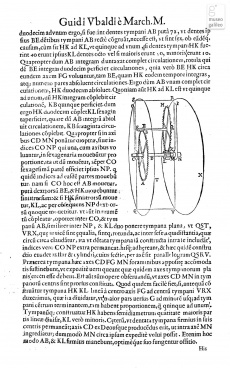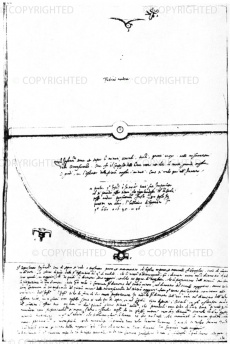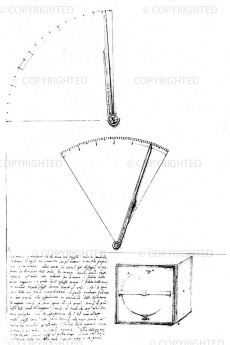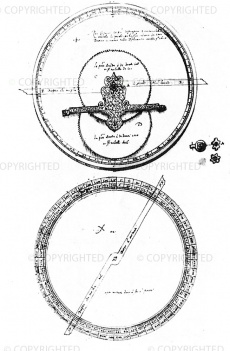Minutes Gauge
From Inventions
Contents |
Inventor
Fabrizio Mordente (1532-ca. 1608)
Historic Period
ca. 1570
Description
Transmission instrument invented by Fabrizio Mordente to measure fractions of a degree. The instrument, described in a manuscript by Giacomo Contarini, consists of a square box with two indexes on the cover, one at the centre describing a 90° arc and one below it describing a 60° arc. The indexes are connected to two wheels mounted inside the box, having diameters in the ratio of 1:60 and connected to each other by a string that transmits the rotary motion from one to the other. Given the ratio between the diameters, moving the larger wheel by one degree causes the smaller wheel to rotate 60°. Accordingly, to measure a fraction of a degree, it is sufficient to move the central index by that amount in order to read on the lower sextant the value of the minutes and, repeating the operation, of the seconds, thirds and so on. Attempting to perfect Mordente's instrument, "in many of its parts imperfect, since in controlling it with the string one cannot be sure that is perfectly correct", Contarini devised one with cogwheels, described in detail in his manuscript. Resembling an astrolabe in shape, the instrument carries on the back a diopter and two graduated circles, the outer one divided into 60°, the inner into 360°. On the mater is a 360° circle and a diopter with two cogwheels, the central one having 108 teeth, the lower one 120. Each wheel has at the centre a sprocket wheel with six teeth meshed to the teething of the other wheel in such a way that, when the diopter on the mater is moved by one degree, the one on the back completes one full rotation, i.e., 60° on the outer scale. Contarini showed this invention to Guidobaldo del Monte, who then devised a variant consisting of two wheels of 72 and 30 teeth, also equipped with six-toothed sprocket wheels, keeping only the 360° circle on the faces of the instrument. Guidobaldo's variant was published, still further perfected, in the Problematum astronomicorum (Venice 1609). The instrument, designed to measure fractions of a degree and parts of the hour circle, had 8 sprocket wheels and two wheels of 72 and 40 teeth, while the faces of the disk carried scales of 360°, 60° and 24 hours.
Bibliographical Resources
Contarini,Giacomo, Figure d'Istromenti Matematici e loro uso, ms, ca. 1590, Oxford, Bodleian Library, Ms. Canon. Ital. 145.
Dal Monte, Guidobaldo,Guidi Ubaldi e Marchionibus Montis Problematum astronomicorum libri septem, Venetiis, apud Bernardum Iuntam, Io. Baptistam Ciottum & socios, 1609.
Images
Author of the entry: Filippo Camerota




